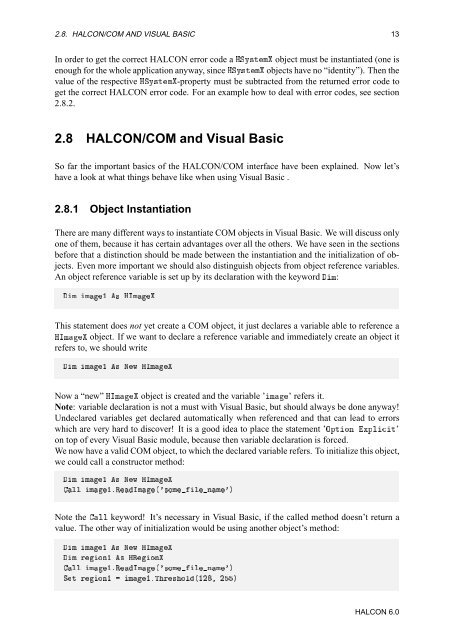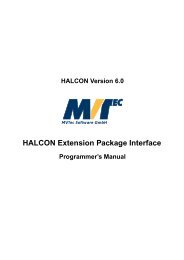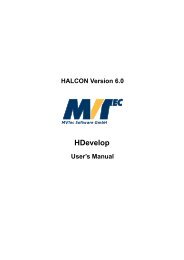HALCON/COM User's Manual
HALCON/COM User's Manual
HALCON/COM User's Manual
Create successful ePaper yourself
Turn your PDF publications into a flip-book with our unique Google optimized e-Paper software.
2.8. <strong>HALCON</strong>/<strong>COM</strong> AND VISUAL BASIC 13<br />
In order to get the correct <strong>HALCON</strong> error code a ÀËÝ×ØÑ object must be instantiated (one is<br />
enough for the whole application anyway, since ÀËÝ×ØÑ objects have no “identity”). Then the<br />
value of the respective ÀËÝ×ØÑ-property must be subtracted from the returned error code to<br />
get the correct <strong>HALCON</strong> error code. For an example how to deal with error codes, see section<br />
2.8.2.<br />
2.8 <strong>HALCON</strong>/<strong>COM</strong> and Visual Basic<br />
So far the important basics of the <strong>HALCON</strong>/<strong>COM</strong> interface have been explained. Now let’s<br />
have a look at what things behave like when using Visual Basic .<br />
2.8.1 Object Instantiation<br />
There are many different ways to instantiate <strong>COM</strong> objects in Visual Basic. We will discuss only<br />
one of them, because it has certain advantages over all the others. We have seen in the sections<br />
before that a distinction should be made between the instantiation and the initialization of objects.<br />
Even more important we should also distinguish objects from object reference variables.<br />
An object reference variable is set up by its declaration with the keyword Ñ:<br />
Ñ Ñ½ × ÀÁÑ<br />
This statement does not yet create a <strong>COM</strong> object, it just declares a variable able to reference a<br />
ÀÁÑ object. If we want to declare a reference variable and immediately create an object it<br />
refers to, we should write<br />
Ñ Ñ½ × ÆÛ ÀÁÑ<br />
Now a “new” ÀÁÑ object is created and the variable ’Ñ’ refers it.<br />
Note: variable declaration is not a must with Visual Basic, but should always be done anyway!<br />
Undeclared variables get declared automatically when referenced and that can lead to errors<br />
which are very hard to discover! It is a good idea to place the statement ’ÇÔØÓÒ ÜÔÐØ’<br />
on top of every Visual Basic module, because then variable declaration is forced.<br />
We now have a valid <strong>COM</strong> object, to which the declared variable refers. To initialize this object,<br />
we could call a constructor method:<br />
Ñ Ñ½ × ÆÛ ÀÁÑ<br />
ÐРѽºÊÁÑ´³×ÓÑÐÒѳµ<br />
Note the ÐÐ keyword! It’s necessary in Visual Basic, if the called method doesn’t return a<br />
value. The other way of initialization would be using another object’s method:<br />
Ñ Ñ½ × ÆÛ ÀÁÑ<br />
Ñ ÖÓÒ½ × ÀÊÓÒ<br />
ÐРѽºÊÁÑ´³×ÓÑÐÒѳµ<br />
ËØ ÖÓÒ½ ѽºÌÖ×Óд½¾¸ ¾µ<br />
<strong>HALCON</strong> 6.0
















